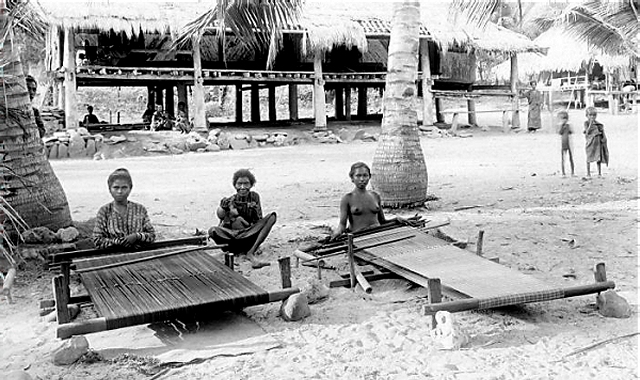Flores: centuries of power struggleFlores, locally known as Nusa Bunga (Flower Island, after the Portuguese), is the central island of the Lesser Sunda Islands, an island arc that extends from Bali in the west till Timor in the East. It is a relatively narrow, 375 km long from west to east, in parts only 25 km wide, nowhere wider than 100 km - and spectacularly scenic. It has several great volcanoes, some of them active, is mostly covered in lush vegetation, and most of the fields are irrigated terraces built on the slopes of mountains, like those on Bali. The name Flores means 'flowers' in Portuguese, and it is not hard to see why the early explorers might have come up with this designation. And there was no local name to compete with: the islanders had no concept of the island as a whole, limited as they were in their knowledge of the world, which hardly extended beyond the next range of hills. Flores, like Timor and several other islands in the archipelago, was long the subject of a power struggle between the Portuguese (who came first) and the Dutch (always close on their heels), with the various strongholds shifting hands multiple times. In 1846, the Dutch and Portuguese governments began negotiations to finally settle their respective claims, but when these still had not been completed five years later, the Portuguese governor of the region, facing financial collapse, decided to sell Flores and the Solor archipelago to the Dutch for a sum of 200,000 florins. Though he did this without consulting the government in Lisbon and was dismissed in disgrace, the agreement was not rescinded. A few years later Flores and the Solor islands were integrated into the Dutch East Indies. During World War II Flores suffered invasion by the Japanese, then in 1945 became a part of independent Indonesia. While these tussles for power were going on, one force managed to maintain its hold on the island: the Dominican Order, which came over in 1613 when the Dutch attacked the Portuguese fort on Solor. Almost the entire population, led by the Dominicans, fled to Larantuka, a harbour town on the southeastern coast of Flores, and there established a flourishing community of mixed descent, called Larantuqueiros or Topasses, which dominated the sandalwood trade for 200 years. The Dominican Order managed to establish itself as the de facto ruler of the island and the Solor Archipelago, and remains a major factor in inter-island trade, finance and shipping.  Women from the Sikka region in East Flores at their backstrap looms. Note a third weaver working under the floor of the longhouse. Photographer unknown, early 20th C. Tropenmuseum of the Royal Tropical Institute (KIT), Creative Commons Licence. Eight different worlds on one islandThe Dutch colonisers - their missionaries forming the notable exception - dealt with the islanders almost exclusively through the various ports, and hardly developed the island's interior. They built only one road, not quite the length of the island, but much of it either never had asphalt or lost it over the years, mostly due to the heavy monsoon rains. Since independence little has been done to improve the infrastructure on Flores. Even these days, a road trip across the length of the island can easily take three days. This difficulty of road transport has caused the development of highly distinct cultures - separate little worlds really, very insular, like islands in an ocean of greenery - where different languages are spoken, different traditions are upheld, and artistic expression has taken on highly differentiated forms. The cloths from the Ngadha area for instance, with their primitive figurative decorations, are really worlds apart from the intricate, patola-inspired textiles from the nearby Lio district, and the Sikka cloths from the area near Maumere, are quite unlike those from Lobe Tobi, which lies in the shade of the same volcano. As far as ikat production is concerned there are seven main areas:
LiteratureWe are blessed with an excellent monograph on the textiles of Flores, Gift of the Cotton Maiden, edited by Roy Hamilton, with contributions by several known scholars. Most of the other books on the textiles of Indonesia have a section on Flores, and there are several good sources for those interested in the ethnology of the island's regions, notable among them Kent Watters article on Flores in Kahlenberg's Textile Traditions of Indonesia.Map of Flores
Detailed maps of Flores by the US Army Map service in high resolution are found at the University of Texas: ©Peter ten Hoopen, 2024. The contents of this website are provided for personal, educational, non-commercial use only. No part of this website may be reproduced in any form without explicit permission of the copyright holder. |
Literature
We are blessed with an excellent monograph on the textiles of Flores, Gift of the Cotton Maiden, edited by Roy Hamilton, with contributions by several known scholars. Most of the other books on the textiles of Indonesia have a section on Flores, and there are several good sources for those interested in the ethnology of the island's regions, notable among them Kent Watters article on Flores in Kahlenberg's Textile Traditions of Indonesia.Map of Flores

Detailed maps of Flores by the US Army Map service in high resolution are found at the University of Texas:
©Peter ten Hoopen, 2024. The contents of this website are provided for personal, educational, non-commercial use only.
No part of this website may be reproduced in any form without explicit permission of the copyright holder.

